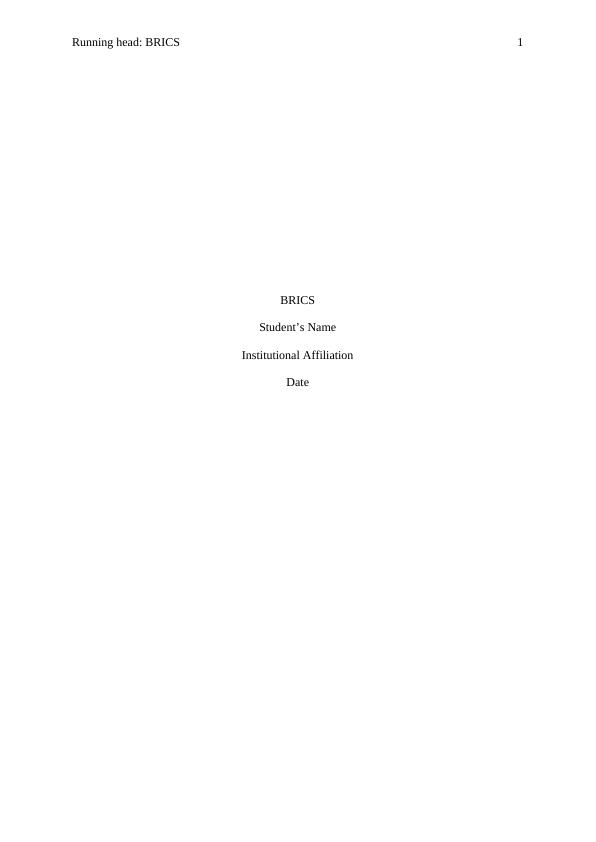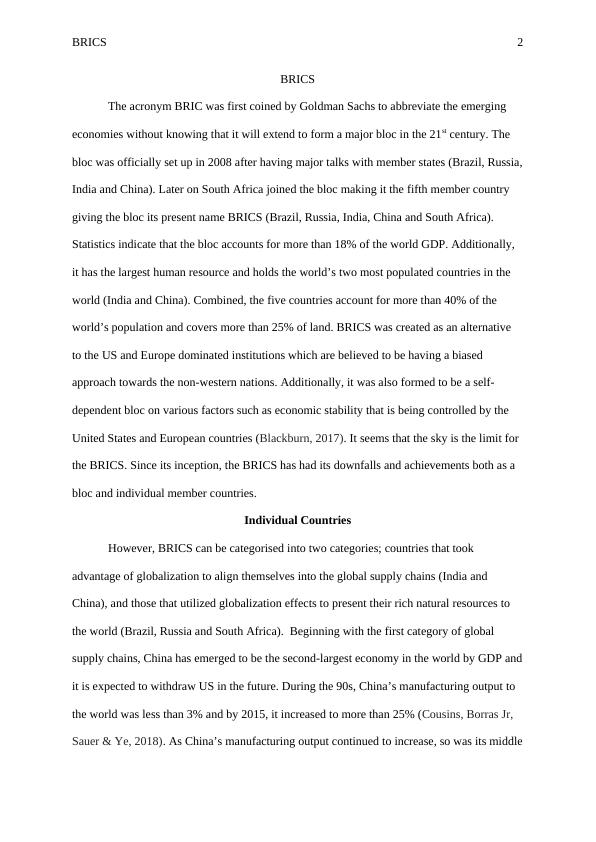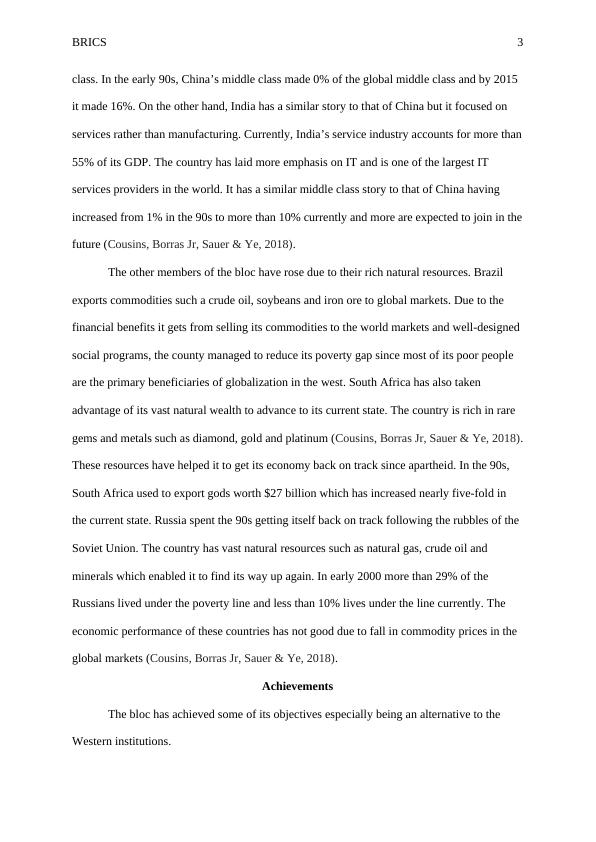BRICS: Achievements and Failures
Added on 2023-06-06
6 Pages1538 Words365 Views
Running head: BRICS 1
BRICS
Student’s Name
Institutional Affiliation
Date
BRICS
Student’s Name
Institutional Affiliation
Date

BRICS 2
BRICS
The acronym BRIC was first coined by Goldman Sachs to abbreviate the emerging
economies without knowing that it will extend to form a major bloc in the 21st century. The
bloc was officially set up in 2008 after having major talks with member states (Brazil, Russia,
India and China). Later on South Africa joined the bloc making it the fifth member country
giving the bloc its present name BRICS (Brazil, Russia, India, China and South Africa).
Statistics indicate that the bloc accounts for more than 18% of the world GDP. Additionally,
it has the largest human resource and holds the world’s two most populated countries in the
world (India and China). Combined, the five countries account for more than 40% of the
world’s population and covers more than 25% of land. BRICS was created as an alternative
to the US and Europe dominated institutions which are believed to be having a biased
approach towards the non-western nations. Additionally, it was also formed to be a self-
dependent bloc on various factors such as economic stability that is being controlled by the
United States and European countries (Blackburn, 2017). It seems that the sky is the limit for
the BRICS. Since its inception, the BRICS has had its downfalls and achievements both as a
bloc and individual member countries.
Individual Countries
However, BRICS can be categorised into two categories; countries that took
advantage of globalization to align themselves into the global supply chains (India and
China), and those that utilized globalization effects to present their rich natural resources to
the world (Brazil, Russia and South Africa). Beginning with the first category of global
supply chains, China has emerged to be the second-largest economy in the world by GDP and
it is expected to withdraw US in the future. During the 90s, China’s manufacturing output to
the world was less than 3% and by 2015, it increased to more than 25% (Cousins, Borras Jr,
Sauer & Ye, 2018). As China’s manufacturing output continued to increase, so was its middle
BRICS
The acronym BRIC was first coined by Goldman Sachs to abbreviate the emerging
economies without knowing that it will extend to form a major bloc in the 21st century. The
bloc was officially set up in 2008 after having major talks with member states (Brazil, Russia,
India and China). Later on South Africa joined the bloc making it the fifth member country
giving the bloc its present name BRICS (Brazil, Russia, India, China and South Africa).
Statistics indicate that the bloc accounts for more than 18% of the world GDP. Additionally,
it has the largest human resource and holds the world’s two most populated countries in the
world (India and China). Combined, the five countries account for more than 40% of the
world’s population and covers more than 25% of land. BRICS was created as an alternative
to the US and Europe dominated institutions which are believed to be having a biased
approach towards the non-western nations. Additionally, it was also formed to be a self-
dependent bloc on various factors such as economic stability that is being controlled by the
United States and European countries (Blackburn, 2017). It seems that the sky is the limit for
the BRICS. Since its inception, the BRICS has had its downfalls and achievements both as a
bloc and individual member countries.
Individual Countries
However, BRICS can be categorised into two categories; countries that took
advantage of globalization to align themselves into the global supply chains (India and
China), and those that utilized globalization effects to present their rich natural resources to
the world (Brazil, Russia and South Africa). Beginning with the first category of global
supply chains, China has emerged to be the second-largest economy in the world by GDP and
it is expected to withdraw US in the future. During the 90s, China’s manufacturing output to
the world was less than 3% and by 2015, it increased to more than 25% (Cousins, Borras Jr,
Sauer & Ye, 2018). As China’s manufacturing output continued to increase, so was its middle

BRICS 3
class. In the early 90s, China’s middle class made 0% of the global middle class and by 2015
it made 16%. On the other hand, India has a similar story to that of China but it focused on
services rather than manufacturing. Currently, India’s service industry accounts for more than
55% of its GDP. The country has laid more emphasis on IT and is one of the largest IT
services providers in the world. It has a similar middle class story to that of China having
increased from 1% in the 90s to more than 10% currently and more are expected to join in the
future (Cousins, Borras Jr, Sauer & Ye, 2018).
The other members of the bloc have rose due to their rich natural resources. Brazil
exports commodities such a crude oil, soybeans and iron ore to global markets. Due to the
financial benefits it gets from selling its commodities to the world markets and well-designed
social programs, the county managed to reduce its poverty gap since most of its poor people
are the primary beneficiaries of globalization in the west. South Africa has also taken
advantage of its vast natural wealth to advance to its current state. The country is rich in rare
gems and metals such as diamond, gold and platinum (Cousins, Borras Jr, Sauer & Ye, 2018).
These resources have helped it to get its economy back on track since apartheid. In the 90s,
South Africa used to export gods worth $27 billion which has increased nearly five-fold in
the current state. Russia spent the 90s getting itself back on track following the rubbles of the
Soviet Union. The country has vast natural resources such as natural gas, crude oil and
minerals which enabled it to find its way up again. In early 2000 more than 29% of the
Russians lived under the poverty line and less than 10% lives under the line currently. The
economic performance of these countries has not good due to fall in commodity prices in the
global markets (Cousins, Borras Jr, Sauer & Ye, 2018).
Achievements
The bloc has achieved some of its objectives especially being an alternative to the
Western institutions.
class. In the early 90s, China’s middle class made 0% of the global middle class and by 2015
it made 16%. On the other hand, India has a similar story to that of China but it focused on
services rather than manufacturing. Currently, India’s service industry accounts for more than
55% of its GDP. The country has laid more emphasis on IT and is one of the largest IT
services providers in the world. It has a similar middle class story to that of China having
increased from 1% in the 90s to more than 10% currently and more are expected to join in the
future (Cousins, Borras Jr, Sauer & Ye, 2018).
The other members of the bloc have rose due to their rich natural resources. Brazil
exports commodities such a crude oil, soybeans and iron ore to global markets. Due to the
financial benefits it gets from selling its commodities to the world markets and well-designed
social programs, the county managed to reduce its poverty gap since most of its poor people
are the primary beneficiaries of globalization in the west. South Africa has also taken
advantage of its vast natural wealth to advance to its current state. The country is rich in rare
gems and metals such as diamond, gold and platinum (Cousins, Borras Jr, Sauer & Ye, 2018).
These resources have helped it to get its economy back on track since apartheid. In the 90s,
South Africa used to export gods worth $27 billion which has increased nearly five-fold in
the current state. Russia spent the 90s getting itself back on track following the rubbles of the
Soviet Union. The country has vast natural resources such as natural gas, crude oil and
minerals which enabled it to find its way up again. In early 2000 more than 29% of the
Russians lived under the poverty line and less than 10% lives under the line currently. The
economic performance of these countries has not good due to fall in commodity prices in the
global markets (Cousins, Borras Jr, Sauer & Ye, 2018).
Achievements
The bloc has achieved some of its objectives especially being an alternative to the
Western institutions.

End of preview
Want to access all the pages? Upload your documents or become a member.
Related Documents
International Political Economy (pdf)lg...
|24
|7853
|15
Political Economy of development PDFlg...
|17
|3859
|21
Analyze Global Trade Environment (pdf)lg...
|12
|2830
|186
The Rise of BRICS from Developing Countries to Emerging Economieslg...
|29
|7490
|27
Global Business Perspectives (MGMT8110)lg...
|11
|3218
|74
MGMT8110 - Global Perspectiveslg...
|13
|565
|81
